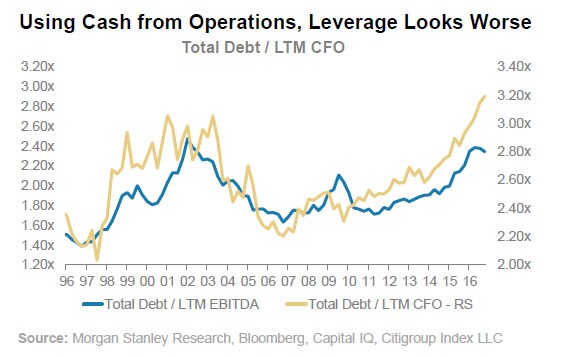The Nasdaq Composite crossed the 6,000 mark for the first time ever Tuesday, following Monday’s broad market surge — the largest one-day gain since March 1. Monday also saw the largest one-day plunge in the CBOE Volatility Index since August 2011, a clear sign of short covering and renewed confidence.
Yet a number of fresh threats on the horizon should give investors pause.
Even as the markets cheer the return of the "Trumpflation" trade in anticipation of the president releasing a tax reform plan on Wednesday — and as the specter of a government shutdown on April 29 also appears to be fading — other challenges loom. These include another potential Federal Reserve rate hike in June, scary corporate debt levels and renewed weakness in crude oil that could drag down energy stocks and overall corporate profitability. Oil prices have sagged as concerns have risen again about the durability of the recent OPEC production freeze. Bloated energy inventories and a rebound in U.S. shale production haven’t helped either.
Related: Why Pro-Business Republicans May Not Embrace Trump’s Massive Tax Cut
Valuations also remain a concern. The S&P 500's current cyclically adjusted price-to-earnings ratio has only been exceeded heading into the 1929 and 2000 market bubble peaks.
A lot of positive expectations are baked into current prices, ignoring that fact that as the economic expansion and bull market grow ever older, fragilities and vulnerabilities multiply. These risks are heightened by the Federal Reserve’s policy tightening campaign. The Fed itself projects two more quarter-point hikes this year and is increasingly discussing the need to start reducing its $4 trillion plus balance sheet back towards its pre-recession level below $1 trillion.
Related: Consumer Confidence Slips; New Home Sales Hit Eight-Month High
Higher interest rates — and the earnings pressure that will come from the resultant upward pressure on the U.S. dollar — will bring attention to the record level of corporate indebtedness. That debt issue was identified by the IMF in its latest Global Financial Stability Report: Balance sheet leverage has surged thanks to years of ultra-low interest rates, ultra-low bond market spreads and investor pressure to boost per share metrics (in a low sales growth environment), which led to debt-fueled stock buybacks and dividend hikes.

This balance sheet "gearing" makes everything look great on the way up, but magnifies the earnings drag from any increase in expenses or decline in revenues, common in the late stages of a business cycle. We could be on the cusp of such shifts as crude oil rolls over again and the "hard economic data" continue to weaken — most notably the downturn in industrial production due to a slowdown in auto sales.
Related: Why the Oil Markets Are Headed for a ‘Decade of Disorder’
Want to keep it simple? Keep an eye on shares of Exxon Mobil (XOM). A selloff here, on crude oil weakness, would confirm fresh pressure on corporate earnings is about to hit -—something the broad market could not ignore for long with earnings multiples so extended.








